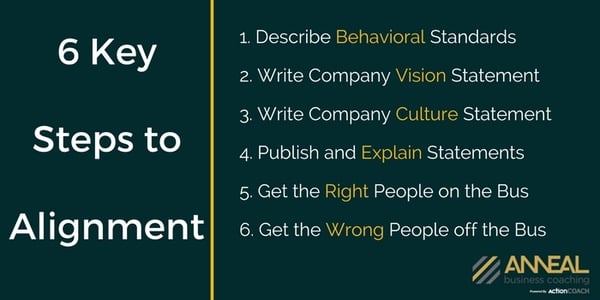7 MIN READ
“It’s important to keep the right people on the bus, but more important to keep the wrong people off.”
Reed Hastings CEO, Netflix
When I first met the founder, he had grown his company from start-up to eight-digit annual sales in under nine years. It appeared to be a tremendous small business success story, but things were not entirely what they seemed.
The company had an insidious flaw which even now threatens to destroy it.
Over the years, the founder had brought in partners on generous terms which included ownership and voting rights. As most of us do, especially in the early stages of business, he selected the partners based on the skills they brought to the enterprise.
He did not pay much attention to their personal behaviors, values, and ambitions. The values and ambitions of two partners happened to align very well.
The third partner was a different story.
The founder and one partner were working intentionally and diligently to build a company that could work without them.
Their behaviors, intent and values were apparent in their vocabulary. Words like “vision,” “team,” “us,” “respect,” “empowerment,” “systems,” “delegation,” and “goals” populated our every discussion.
The other partner’s values were also apparent. Any conversation contained an endless stream of words such as “I,” “me,” “my,” “mine,” and “I know”.

I quickly recognized this partner as the “dirty hands” type. This type does not believe he is working unless he gets his hands “dirty” by spending long hours at work, overseeing the details and turning a wrench to “...show ‘em how it’s done.”
Such people wear the dirty fingernails of micromanagement as a badge of honor.
Over time, the third partner began to make comments like “I do all the work around here,” “I’m getting tired of supporting you guys,” and “Get out of my way, and let me run things.”
The problem came to a head when he began to act on that last statement by taking important actions without consensus or even informing his two partners.
This story is unresolved.
"We cannot look for traits we haven’t identified and we can’t align people until we have something to align them to."
The partners are mired in legal battles that are diverting precious time and money from operations and growth. The resolution will affect not only the business, its owners and their families, but also employees and the hundreds of customers who have come to rely on it.
If the company fails, it will be a tragedy, and the cause is misaligned behaviors, vision and values.
Sadly, this is a common story in small business.
Few of us business owners, especially in the scramble of early years, devote much thought to aligning our behaviors, vision and values with those of our business partners, families, and employees.
As the story illustrates, alignment is a crucial process we cannot afford to overlook.
We all have ambitions and values, but most of us have not written them down or even thought much about them. Doing so is the first step toward alignment, because we cannot look for traits we haven’t identified and we can't align people until we have something to align them to.
Our business partners
Our families, and
Our team
Our behavioral standards,
Our vision for the future, and
Our values.
Behaviors are how we conduct ourselves, especially when confronting problems. There are damaging behaviors which compound problems, and there are constructive behaviors which help resolve problems.
Which behaviors characterize our companies is first a matter of awareness. By paying attention, we can we can recognize and describe acceptable behaviors.
Second, it is entirely a matter of choice.
Once we know what we want, we can change behaviors in our companies either by changing the way people behave - or by changing the people.
My article “It’s up to you: Living Life Above the Bar” shows how simple it can be to recognize and describe appropriate behaviors.
Vision is a picture of our business in the future. It shows what it provides to whom and what it stands for.
It is our big goal that provides meaning, purpose and direction for everything we do.
Without a vision, people flounder as they pursue different agendas, often working at cross-purposes. In the example above, the three partners clearly had different visions for the company.
Two were working to build a self-sustaining company that provided not only a living, but also meaning, to the team by empowering them with autonomy and purpose.
The third partner was working to build a business that fed his ego.
For help writing a clear and inspiring vision for your company, see my article “How to Create a Powerful Vision for Your Company.”
Brian Tracy, the business author, defines values as “What we stand for, and even more, what we won’t stand for.”
"Groups of people with compatible values are gathered, not made."
Values are deep-seated in the core of who we are. They are non-negotiable and unlike behaviors, they are difficult, if not impossible, to change.
That means that groups of people with compatible values are gathered, not made.
Just as the two partners above are unlikely to change the values of the third, we are unlikely to change the values of that “difficult” employee who is always at the center of workplace drama.
The aggregate values of a company, what it will or will not stand for, comprise the culture of the company. Every company has one it whether arose spontaneously, as happened above, or intentionally.
Intentional is better, which means we have to define our culture and write it down in a culture statement.
A culture statement is a list of our values and is arguably the most important element of alignment.
Because values are difficult to change, not much can be done to resolve conflict except to part with people whose values don't align with ours. It is a far better strategy to not hire such people in the first place, which is why alignment with a written culture statement is so important.
See my article “How to get Along Around Here” for help writing your culture statement, and check out Brian Tracy's extensive list of values to help get you started.
"We owe it to others and to ourselves to align people to our expectations, both in writing and in person."
In an ideal world, we would have set our behavioral standards and created our vision and culture statements long before we acquired partners, employees, and maybe even our families.
That would make life easier because we could gather the right people on the bus from the start. However, it doesn’t often work that way.
Like the founder above, most of us don’t think about such matters until they become problems, well after key relationships have been established.
Regardless, we owe it to them and to ourselves to align people to our expectations, both in writing and in person. We have to begin wherever we are, and we do that by making our expectations and standards known in interviews with prospective hires, in company meetings, in employee reviews and most important - in our own behavior.

Describe our behavioral standards.
Get the right people on the bus
Get the wrong people off (quickly)
Do you have people on the bus who don’t belong? Does your business have a clear compelling purpose? Do prevailing behaviors help or compound problems? Does your family believe in and support your business?
Thank you for reading this article. As always, I value and welcome your comments in the comment box below. I also welcome your ideas for future articles.